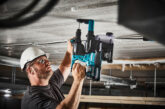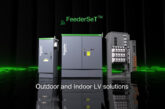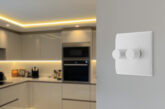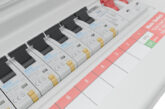
We sit down with Philip Grove, Circuit Protection Product Manager at Luceco, to chew the fat over the latest developments in circuit protection as we head towards a more prosumer-conscious society.
Although he may be a relative newbie to employment within the electrical sector, having started his role as Product Manager for Circuit Protection at BG/Luceco in July of last year, electrical blood certainly runs through Philip’s veins via his father who was a sparky by trade and whose experience dates back to the 14th Edition, way back in 1966. By amazing coincidence, his initials are also ‘BG’.
With that experience of being around the electrical industry throughout his life, Philip is now tasked with the development of BG’s circuit protection offering and to put into practice the brand’s vision for the future
He explains: “First and foremost I have a passion and aptitude for products and product development in general, so this is an exciting challenge for me moving forwards.
As a very hands-on Product Manager, I also want to get out and about and meet people, including our wholesaler partners and our end user electrical customers.
“Here we can garner valuable feedback and market intelligence so that we’re able to understand the needs and opportunities in this particular sector, and to have a clear direction of where we need to be heading in terms of product development.”
One particular area of focus that will keep Philip nicely occupied moving forwards is the growing shift towards ‘prosumer’ adoption and applications, and the need for circuit protection solutions that can meet these demands.
He explains: “The biggest change we’re noticing is that individuals are now looking much more closely at the cost of energy and where there may be opportunities to make savings, which points back towards the prosumer side of things.
“Obviously the government’s net-zero commitments are also a significant factor that will drive industry and change, with more consumers pushing to have EV charging capability at home. It’s the integration of these products, and the solutions required to make this possible, that is the real challenge currently.”
Second thoughts
With increased power demands on residential properties, and because of the nature and set up of modern homes these days, the requirement for the installation of a secondary consumer unit is now a very important consideration.
Philip believes this forms one of two key trends that have emerged when it comes to EV chargepoint installations:
1. In the case of a brand new installs, it’s the provision and the ability to engineer consumer units that can handle heavy, continuous loads of up to 7 kW which can be running for anything up to 10 hours on charge. In this case, you need to make sure you have the right devices and also a certified and approved enclosure, which has been a big development that the market has had to deal with.
2. Many electricians simply don’t want to touch an installation that’s already there, as they have absolutely no idea what they might find inside once they take the cover off. As a result, the quickest and easiest route to avoid this is to install a secondary consumer unit.
With that latter point in mind, there are a number of mixed industry messages currently regarding the ideal location for the secondary unit, something Philip is keen to clear up.
He states: “You actually have a choice to install either outside or inside. Ideally you’d want the unit installed internally, sat alongside the main CU so that if you do get a problem or fault you have everything contained within one location.
“However, with new builds you’re often dealing with a switch fuse unit that is in your meter cabinet and you’ve got a 3 metre+ distance to where your main consumer unit is positioned.
“A lot of houses are smaller now and the fabrication and structure makes it difficult to install second units in the same location as the existing unit. As such, many installers are taking an easier option to either install outside, or inside in close proximity to the existing meter.”
The IP crowd
When considering the installation of a secondary outdoor unit, one may automatically look towards the IP rating as the main factor in the choice of the product, but Philip is quick to point out that this is just one consideration that needs to take place.
He says: “Although it’s important, the IP rating is not the only critical element of the enclosure, so we’ve looked at a whole spectrum of factors that will support that application. For example, we also take into account the temperature of where the product will be installed (outside or inside). Your devices might be certified for indoor use temperatures but what about outside?
“We’ve type tested our devices and certified them down to -25 ̊C to meet this need, and I’d always recommend that you look for the symbols and identification points in that regard.”
Philip continues: “We’ve also made the provision within the enclosures for the changes that came with Amendment 3, as well as making sure they’re tested to Pollution Degree 3.
“This is important because if you put the consumer unit outside, the characteristics of the unit outdoors compared to indoors will be completely different as you’re potentially dealing with lots of contamination that can build up over time and cause issues. Pollution Degree 3 helps to safeguard the product in that regard.”
Indoors or outdoors?
As someone who is able to speak to electricians on their level, Philip is keen to simplify the whole conversation around secondary consumer unit use and its suitability for either indoor or outdoor applications, stating: “We basically explain that we have three platforms and a choice of three locations:
1. For indoor use in a dry environment there is our IP20 unit,
2. For indoor or outdoor use you have our IP65 fire rated unit,
3. For sole outdoor use there is our new plastic alternative which is IP66 rated.
“Within these units we can offer a whole array of configurations, such as having them populated with MCBs, RCBOs, RCDs, or additional combinations of devices. We can also offer bespoke, configured solutions through both the Sync Energy and BG websites, where you can choose and tailor the solution for yourself.
“All of these products are ready to go off-the-shelf, but if you want something special for a particular application, we have the ability to build a configured bespoke offering at our Telford site.”
In the second part of this interview, which will be published in PE’s June issue, we’ll be talking to Philip about the latest updates with bidirectional devices and taking a look at BG’s technical and training support offering to the industry.
Get more details about the BG range of circuit protection solutions here
Find more industry feature articles here










